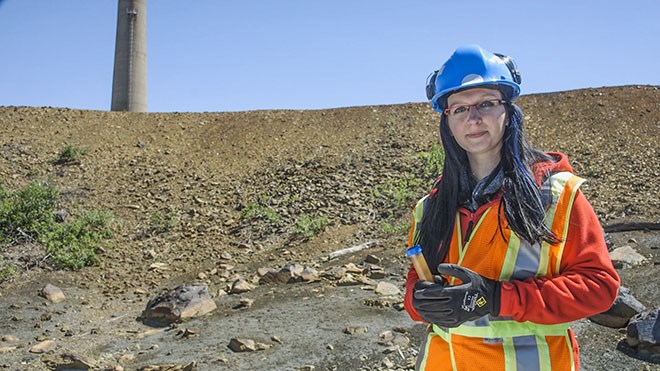The tiny microbes that Nadia Mykytczuk cultivates in a Sudbury laboratory could have a huge impact in dealing with the legacy issues of mine waste.
The billions of dollars it will take to tackle the problem of treating these industrial legacy sites are not only a burden on governments, but the remediation poses a major headache for operating mines and the introduction of new development.
Laurentian University’s Mykytczuk, an environmental microbiologist at Vale Living with Lakes Centre, has been developing cost-effective, green alternatives to deal with these long-term challenges while finding ways of pulling value from the waste material.
“Industry, government and communities are recognizing that our legacy issues around mining are very costly,” said Mykytczuk, the NOHFC Industrial Chair in Biomining, Bioremediation and Science Communication at Laurentian.
“They affect social licence and the ability for companies to open new mines if they haven’t dealt with their old problems.
“There’s a huge opportunity to not only clean up these sites but extract value at the same time.”
Mykytczuk works with a number of companies on remediation applications, such as Sudbury mining giants Vale and Glencore, but she’s garnered the most attention for her work with BacTech Environmental on a bioleaching project in Ecuador.
The Toronto company has a proprietary technology that uses naturally occurring bacteria inside fermentation tanks to recover gold from mine tailings while stabilizing the arsenic found in the tailings.
Mykytczuk hooked up with BacTech through the Ontario Genomics Institute, which recognized that expertise in microbiology and molecular biology was the perfect fit for the company that worked with microbes.
They secured a grant in 2014 to help optimize the technology they had been applying at a number of different sites.
Mykytczuk helped the company identify the ideal bacteria required for their process and the tank conditions to nurture their growth.
The relationship has grown to the point of setting up a test facility with bioreactors at Cambrian College in Sudbury for the Ecuador project, which involves artisanal mine wastes – with high arsenic tailings – left over by small mom-and-pop shops.
“We’ve completed a year’s worth of test work to find the best bugs, under the best conditions, to extract the gold out of this high arsenic material,” she said.
In her collection, Mykytczuk has bugs from more than 300 mine sites, including some inherited strains from the university’s research at the Elliot Lake mines in the early 1990s.
Inside a tailings pile is a thriving ecosystem, inhabited by an abundance of microbes that can be harnessed to break down waste and extract precious metals.
“But if you take a handful of tailings from Copper Cliff or Ecuador you have thousands to millions of individual organisms, and that diversity matters because those bugs are best adapted to those conditions,” she said.
“Nature knows best. It will have picked bugs that can grow in a particular situation. My goal is to demonstrate that we can use this technology to reprocess the many thousands of abandoned mines here that still hold a lot of value.
“What’s nice is that the bugs we have here in Sudbury – unlike the ones in Latin America – are actually cold adapted.”
Her work revolves around manipulating those microbial communities to find the right recipe and match the right microbes to specific waste types to optimize the outcome. Eventually, she hopes to take those technologies from the bench to the commercial stage.
Mykytczuk said Canada is behind other countries in making advances in bioleaching and bio-mining because with the luxury of having abundant space and mineral wealth, we feel addressing problems of waste piles isn’t a priority.
“But we should because the legacy issues are becoming very costly and unacceptable.”
To accelerate that research, Mykytczuk is proposing the development of Canada’s first Centre for Mine Waste Biotechnology for Sudbury, a research and commercialization hub to allow for solid and liquid mine waste technology research to be taken from the lab and applied in the field.
Similar to other technology incubators in Ontario, the research centre would be a multi-million-dollar endeavour, built on various funding partnerships with environmental companies in creating products that solve problems and create solutions for industry.
With the centre, she hopes to create an industrial research cluster that will provide a “nursery” to commercialize university research and find some cross-collaborations with other biotechnologies, nanotechnologies or material sciences that might have industrial use.
Besides a new R&D capacity for Sudbury, there’s an opportunity to create a workforce trained in leading-edge brownfield remediation techniques.
“There are thousands of sites that we could be working on and there’s simply not enough.”
Mykytczuk said Sudbury is a natural fit for such a centre with its history of mining, a world-renowned model for land reclamation and remediation, the existing research capacity, and an outdoor laboratory to develop these biotechnologies to deal with these mine waste issues.
There’s also the potential to establish a cluster for training in remediation techniques and technologies, as well as spurring a number of spinoff companies specializing in developing microbial communities or performing molecular testwork.
“These are areas where no one company is ever going to do all of it.”
The Drift magazine, a new publication from Northern Ontario Business, features profiles on the people and companies making important contributions to the Northern Ontario mining service and supply industry.




